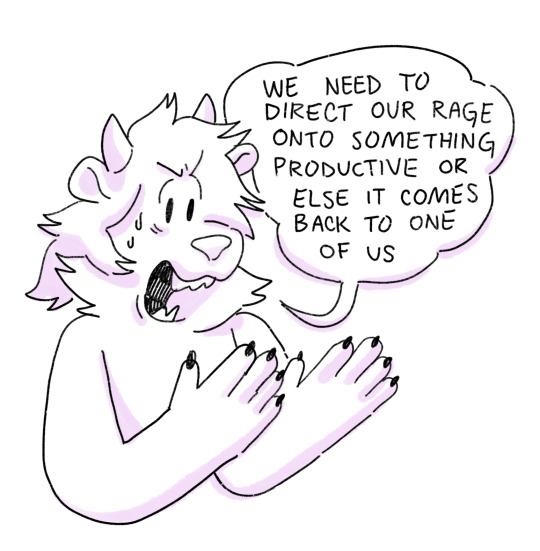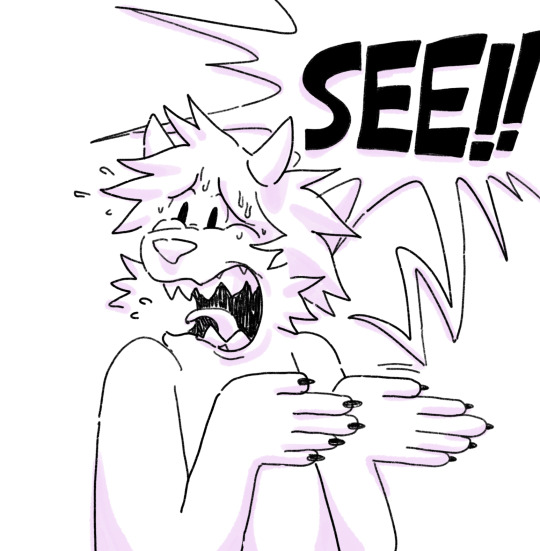#posted for my own enjoyment
Photo




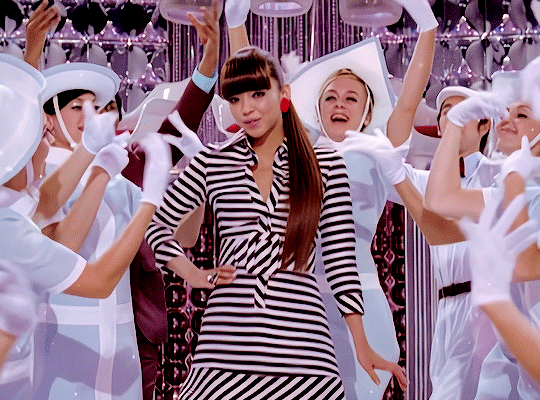

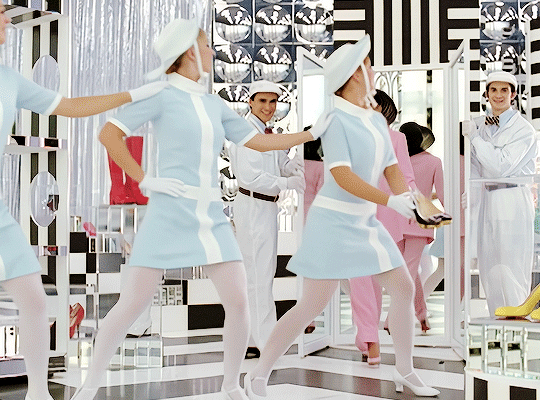


NEW LOOK (2008)
NAMIE AMURO
#namie amuro#amuro namie#jpop#jpopnetedit#jpopgifs#mygif#idk what im supposed to tag omfg#posted for my own enjoyment#<3
234 notes
·
View notes
Text
None Of You Know What Haiku Are
I'm going to preface this by saying that i am not an expert in ANY form of poetry, just an enthusiast. Also, this post is... really long. Too long? Definitely too long. Whoops! I love poetry.
If you ask most English-speaking people (or haiku-bot) what a haiku is, they would probably say that it's a form of poetry that has 3 lines, with 5, and then 7, and then 5 syllables in them. That's certainly what I was taught in school when we did our scant poetry unit, but since... idk elementary school when I learned that, I've learned that that's actually a pretty inaccurate definition of haiku. And I think that inaccurate definition is a big part of why most people (myself included until relatively recently!) think that haiku are kind of... dumb? unimpressive? simple and boring? I mean, if you can just put any words with the right number of syllables into 3 lines, what makes it special?
Well, let me get into why the 5-7-5 understanding of haiku is wrong, and also what makes haiku so special (with examples)!
First of all, Japanese doesn't have syllables! There's a few different names for what phonetic units actually make up the language- In Japanese, they're called "On" (音), which translates to "sound", although English-language linguists often call it a "mora" (μ), which (quoting from Wikipedia here) "is a basic timing unit in the phonology of some spoken languages, equal to or shorter than a syllable." (x) "Oh" is one syllable, and also one mora, whereas "Oi" has one syllable, but two moras. "Ba" has one mora, "Baa" has two moras, etc. In English, we would say that a haiku is made up of three lines, with 5-7-5 syllables in them, 17 syllables total. In Japanese, that would be 17 sounds.
For an example of the difference, the word "haiku", in English, has 2 syllables (hai-ku), but in Japanese, はいく has 3 sounds (ha-i-ku). "Christmas" has 2 syllables, but in Japanese, "クリスマス" (ku-ri-su-ma-su) is 5 sounds! that's a while line on its own! Sometimes the syllables are the same as the sounds ("sushi" is two syllables, and すし is two sounds), but sometimes they're very different.
In addition, words in Japanese are frequently longer than their English equivalents. For example, the word "cuckoo" in Japanese is "ほととぎす" (hototogisu).
Now, I'm sure you're all very impressed at how I can use an English to Japanese dictionary (thank you, my mother is proud), but what does any of this matter? So two languages are different. How does that impact our understanding of haiku?
Well, if you think about the fact that Japanese words are frequently longer than English words, AND that Japanese counts sounds and not syllables, you can see how, "based purely on a 17-syllable counting method, a poet writing in English could easily slip in enough words for two haiku in Japanese” (quote from Grit, Grace, and Gold: Haiku Celebrating the Sports of Summer by Kit Pancoast Nagamura). If you're writing a poem using 17 English syllables, you are writing significantly more content than is in an authentic Japanese haiku.
(Also not all Japanese haiku are 17 sounds at all. It's really more of a guideline.)
Focusing on the 5-7-5 form leads to ignoring other strategies/common conventions of haiku, which personally, I think are more interesting! Two of the big ones are kigo, a season word, and kireji, a cutting word.
Kigo are words/phrases/images associated with a particular season, like snow for winter, or cherry blossoms for spring. In Japan, they actually publish reference books of kigo called saijiki, which is basically like a dictionary or almanac of kigo, describing the meaning, providing a list of related words, and some haiku that use that kigo. Using a a particular kigo both grounds the haiku in a particular time, but also alludes to other haiku that have used the same one.
Kireji is a thing that doesn't easily translate to English, but it's almost like a spoken piece of punctuation, separating the haiku into two parts/images that resonate with and add depth to each other. Some examples of kireji would be "ya", "keri", and "kana." Here's kireji in action in one of the most famous haiku:
古池や 蛙飛び込む 水の音
(Furu ike ya kawazu tobikomu mizu no oto)
(The old pond —
A frog jumps in
The sound of the water.)
You can see the kireji at the end of the first line- 古池や literally translates to "old pond ya". The "ya" doesn't have linguistic meaning, but it denotes the separation between the two focuses of the haiku. First, we are picturing a pond. It's old, mature. The water is still. And then there's a frog! It's spring and he's fresh and new to the world! He jumps into the pond and goes "splash"! Wowie! When I say "cutting word", instead of say, a knife cutting, I like to imagine a film cut. The camera shows the pond, and then it cuts to the frog who jumps in.
English doesn't really have a version of this, at least not one that's spoken, but in English language haiku, people will frequently use a dash or an ellipses to fill the same role.
Format aside, there are also some conventions of the actual content, too. They frequently focus on nature, and are generally use direct language without metaphor. They use concrete images without judgement or analysis, inviting the reader to step into their shoes and imagine how they'd feel in the situation. It's not about describing how you feel, so much as it's about describing what made you feel.
Now, let's put it all together, looking at a haiku written Yosa Buson around 1760 (translated by Harold G. Henderson)
The piercing chill I feel:
my dead wife's comb, in our bedroom,
under my heel
We've got our kigo with "the piercing chill." We read that, and we imagine it's probably winter. It's cold, and the kind of cold wind that cuts through you. There's our kireji- this translation uses a colon to differentiate our two images: the piercing chill, and the poet stepping on his dead wife's comb. There's no descriptions of what the poet is feeling, but you can imagine stepping into his shoes. You can imagine the pain he's experiencing in that moment on your own.
"But tumblr user corvidcall!" I hear you say, "All the examples you've used so far are Japanese haiku that have been translated! Are you implying that it's impossible for a good haiku to be written in English?" NO!!!!! I love English haiku! Here's a good example, which won first place in the 2000 Henderson haiku contest, sponsored by the Haiku Society of America:
meteor shower . . .
a gentle wave
wets our sandals
When you read this one, can you imagine being in the poet's place? Do you feel the surprise as the tide comes in? Do you feel the summer-ness of the moment? Haiku are about describing things with the senses, and how you take in the world around you. In a way, it's like the poet is only setting a scene, which you inhabit and fill with meaning based on your own experiences. You and I are imagining different beaches, different waves, different people that make up the "our" it mentioned.
"Do I HAVE to include all these things when I write haiku? If I include all these things, does that mean my haiku will be good?" I mean, I don't know. What colors make up a good painting? What scenes make up a good play? It's a creative medium, and nobody can really tell you you can't experiment with form. Certainly not me! But I think it's important to know what the conventions of the form are, so you can appreciate good examples of it, and so you can know what you're actually experimenting with. And I mean... I'm not the poetry cops. But if you're not interested in engaging with the actual conventions and limitations of the form, then why are you even using that form?
I'll leave you with one more English language haiku, which is probably my favorite haiku ever. It was written by Tom Bierovic, and won first place at the 2021 Haiku Society of America Haiku Awards
a year at most . . .
we pretend to watch
the hummingbirds
Sources: (x) (x) (x) (x) (x) (x)
Further reading:
Forms in English Haiku by Keiko Imaoka
Haiku: A Whole Lot More Than 5-7-5 by Jack
How to Write a Bad Haiku by KrisL
Haiku Are Not a Joke: A Plea from a Poet Who Has Had It Up to Here by Sandra Simpson
Haiku Checklist by Katherine Raine
#poetry#haiku#writing#literature#anime life#long post#i want to apologize but i had to get something off my chest#and the thing was. i love haiku#and when i see posts on here about haiku. i get so angy.#well ok i really get more disappointed bc nobody is really engaging with the form on its own terms#anyway i hope you enjoy some of my favorite haiku because theyre in there!!!!!#i didnt really get into the history of haiku. and i also did not get into why i got really into it#but i will say that i was really inspired by Jacob Geller's video A Thousand Ways of Seeing a Forest#which is a lot about translation#(which i mean. as an interpreter AND a poetry-enjoyer. really appealed to me lol)
10K notes
·
View notes
Text
Very interesting to me that a certain subset of the BES fandom's favourite iterations of Mizu and Akemi are seemingly rooted in the facades they have projected towards the world, and are not accurate representations of their true selves.
And I see this is especially the case with Mizu, where fanon likes to paint her as this dominant, hyper-masculine, smirking Cool GuyTM who's going to give you her strap. And this idea of Mizu is often based on the image of her wearing her glasses, and optionally, with her cloak and big, wide-brimmed kasa.
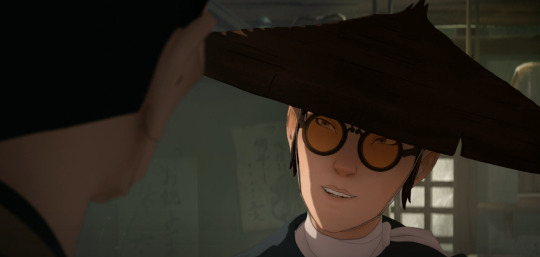

And what's interesting about this, to me, is that fanon is seemingly falling for her deliberate disguise. Because the glasses (with the optional combination of cloak and hat) represent Mizu's suppression of her true self. She is playing a role.

Take this scene of Mizu in the brothel in Episode 4 for example. Here, not only is Mizu wearing her glasses to symbolise the mask she is wearing, but she is purposely acting like some suave and cocky gentleman, intimidating, calm, in control. Her voice is even deeper than usual, like what we hear in her first scene while facing off with Hachiman the Flesh-Trader in Episode 1.
This act that Mizu puts on is an embodiment of masculine showboating, which is highly effective against weak and insecure men like Hachi, but also against women like those who tried to seduce her at the Shindo House.


And that brings me to how Mizu's mask is actually a direct parallel to Akemi's mask in this very same scene.
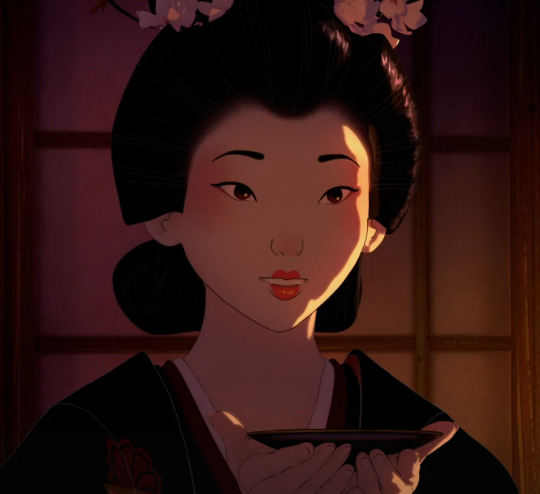
Here, Akemi is also putting up an act, playing up her naivety and demure girlishness, using her high-pitched lilted voice, complimenting Mizu and trying to make small talk, all so she can seduce and lure Mizu in to drink the drugged cup of sake.
So what I find so interesting and funny about this scene, characters within it, and the subsequent fandom interpretations of both, is that everyone seems to literally be falling for the mask that Mizu and Akemi are putting up to conceal their identities, guard themselves from the world, and get what they want.
It's also a little frustrating because the fanon seems to twist what actually makes Mizu and Akemi's dynamic so interesting by flattening it completely. Because both here and throughout the story, Mizu and Akemi's entire relationship and treatment of each other is solely built off of masks, assumptions, and misconceptions.
Akemi believes Mizu is a selfish, cocky male samurai who destroyed her ex-fiance's career and life, and who abandoned her to let her get dragged away by her father's guards and forcibly married off to a man she didn't know. on the other hand, Mizu believes Akemi is bratty, naive princess who constantly needs saving and who can't make her own decisions.
These misconceptions are even evident in the framing of their first impressions of each other, both of which unfold in these slow-motion POV shots.
Mizu's first impression of Akemi is that of a beautiful, untouchable princess in a cage. Swirling string music in the background.
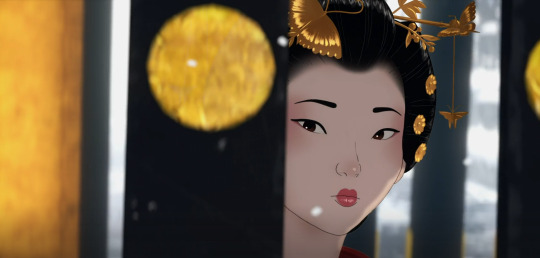
Akemi's first impression of Mizu is of a mysterious, stoic "demon" samurai who stole her fiance's scarf. Tense music and the sound of ocean waves in the background.

And then, going back to that scene of them together in Episode 4, both Mizu and Akemi continue to fool each other and hold these assumptions of each other, and they both feed into it, as both are purposely acting within the suppressive roles society binds them to in order to achieve their goals within the means they are allowed (Akemi playing the part of a subservient woman; Mizu playing the part of a dominant man).

But then, for once in both their lives, neither of their usual tactics work.
Akemi is trying to use flattery and seduction on Mizu, but Mizu sees right through it, knowing that Akemi is just trying to manipulate and harm her. Rather than give in to Akemi's tactics, Mizu plays with Akemi's emotions by alluding to Taigen's death, before pinning her down, and then when she starts crying, Mizu just rolls her eyes and tells her to shut up.

On the opposite end, when Mizu tries to use brute force and intimidation, Akemi also sees right through it, not falling for it, and instead says this:
"Under your mask, you're not the killer you pretend to be."

Nonetheless, despite the fact that they see a little bit through each other's masks, they both still hold their presumptions of each other until the very end of the season, with Akemi seeing Mizu as an obnoxious samurai swooping in to save the day, and Mizu seeing Akemi as a damsel in distress.
And what I find a bit irksome is that the fandom also resorts to flattening them to these tropes as well.
Because Mizu is not some cool, smooth-talking samurai with a big dick sword as Akemi (and the fandom) might believe. All of that is the facade she puts up and nothing more. In reality, Mizu is an angry, confused and lonely child, and a masterful artist, who is struggling against her own self-hatred. Master Eiji, her father figure who knows her best, knows this.

And Akemi, on the other hand, is not some girly, sweet, vain and spoiled princess as Mizu might believe. Instead she has never cared for frivolous things like fashion, love or looks, instead favouring poetry and strategy games instead, and has always only cared about her own independence. Seki, her father figure who knows her best, knows this.
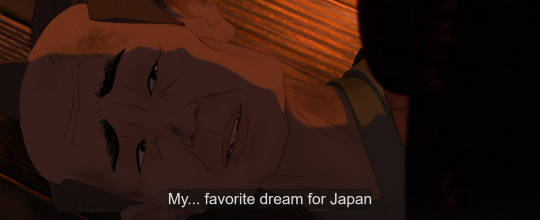

But neither is she some authoritative dominatrix, though this is part of her new persona that she is trying to project to get what she wants. Because while Akemi is willful, outspoken, intelligent and authoritative, she can still be naive! She is still often unsure and needs to have her hand held through things, as she is still learning and growing into her full potential. Her new parental/guardian figure, Madame Kaji, knows this as well.
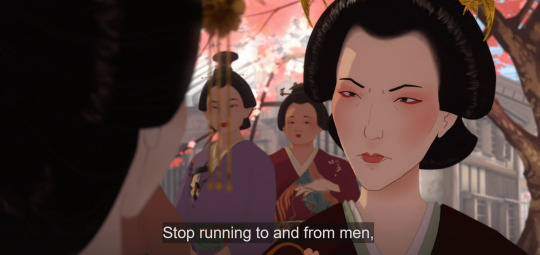
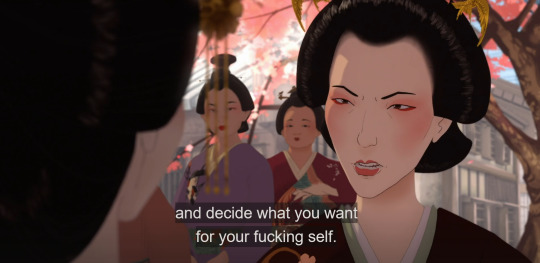
So with all that being said, now that we know that Mizu and Akemi are essentially wearing masks and putting up fronts throughout the show, what would a representation of Mizu's and Akemi's true selves actually look like? Easy. It's in their hair.
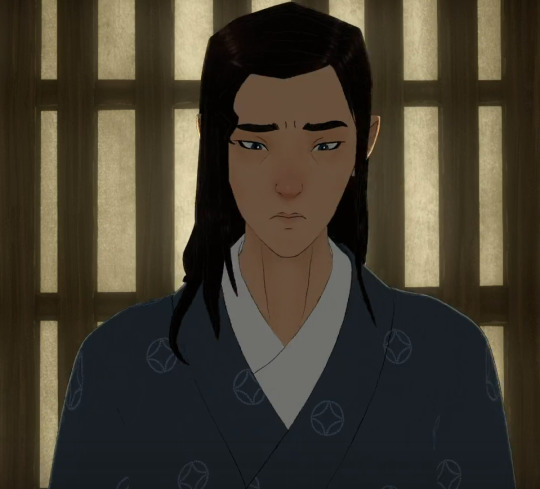

This shot on the left is the only time we see Mizu with her hair completely down. In this scene, she's being berated by Mama, and her guard is completely down, she has no weapon, and is no longer wearing any mask, as this is after she showed Mikio "all of herself" and tried to take off the mask of a subservient housewife. Thus, here, she is sad, vulnerable, and feeling small (emphasised further by the framing of the scene). This is a perfect encapsulation of what Mizu is on the inside, underneath all the layers of revenge-obsession and the walls she's put around herself.
In contrast, the only time we Akemi with her hair fully down, she is completely alone in the bath, and this scene takes place after being scorned by her father and left weeping at his feet. But despite all that, Akemi is headstrong, determined, taking the reigns of her life as she makes the choice to run away, but even that choice is reflective of her youthful naivety. She even gets scolded by Seki shortly after this in the next scene, because though she wants to be independent, she still hasn't completely learned to be. Not yet. Regardless, her decisiveness and moment of self-empowerment is emphasised by the framing of the scene, where her face takes up the majority of the shot, and she stares seriously into the middle distance.
To conclude, I wish popular fanon would stop mischaracterising these two, and flattening them into tropes and stereotypes (ie. masculine badass swordsman Mizu and feminine alluring queen but also girly swooning damsel Akemi), all of which just seems... reductive. It also irks me when Akemi is merely upheld as a love interest and romantic device for Mizu and nothing more, when she is literally Mizu's narrative foil (takes far more narrative precedence over romantic interest) and the deuteragonist of this show. She is her own person. That is literally the theme of her entire character and arc.
#blue eye samurai#mizu blue eye samurai#akemi blue eye samurai#blue eye samurai meta#just in case... im gonna tag this as#mizukemicritical#akemizucritical#though this post isnt actually criticising the ship itself but rather fanon's portrayal of the ship and the characters#for that reason lemme also tag this as#wank.mp3#feel free to disagree of course but please be civil#and if you need to rant about how wrong i am without any convincing evidence kindly feel free to make your own post. peace and love <3#fandom.rtf#meta dissertations.pdf#shut up haydar#edit: for full disclosure. i do rather dislike this ship. but obviously it's fine for anyone to enjoy it. please do! have your fun!#it's just that as usual! popular fanon and fandom around a ship is what has completely deterred me from any sense of enjoyment of it#it's a shame too because i was very open and even eager for some mizu/akemi romance in the future#but out-of-character fanon + the rudeness of certain fans has definitely soured it for me#but that doesn't mean people can't enjoy it obviously! ship and let ship!!!#plus it has its appeal which i DO STILL see and enjoy!!!!#i would even go as far as to call them soulmates because their narratives and characters are LITERALLY intertwined!!!#but. yeah. my gradual distaste for this ship is indeed very unfortunate.
678 notes
·
View notes
Text
me, coming to this website every single day: don't look at the like/reblog ratio don't look at the like/reblog ratio don't look at the like/reblog ratio don't look at the like/reblog ratio don't look at the like/reblog ratio don't look at the like/reblog ratio don't look-
#life#like every single fucken time!!!#i scroll through my dash and see gifs or art and stuff#and my hand is just gliding to the notes#it's fucking depressing honestly#and if i do that to my own posts it's fucking over#like i've been trying my best to focus on just making stuff for my own enjoyment and artistic expression#but that well is running dry ngl#people here take so much shit for granted everything is fucking content to be consumed#so many blogs just hoard posts in their likes like a little board in their room where they pin posts#it's exhausting honestly
480 notes
·
View notes
Text
psa that the day there are no jgy stans left on tumblr dot com is the day i am dead
but rest assured i'll go to my grave exactly as i lived: obnoxiously proclaiming to everyone within earshot how great lianfang-zun is. narratively, metaphorically, spiritually. sexually, too, like why limit myself. i like to keep my options open
#the spirit of su minshan possessed me for a minute there but like. i'm fine with it#jin guangyao#he did crimes??? good for him 😌#editing this post to add that while the tone here is clearly joking#i really am fundamentally still engaged with this fandom#and with this book#almost exlcusively because of my enjoyment of jgy#even xiyao is secondary for me like i love it and i'm ride or die for it obvs#but jgy as a character is the main draw for me. and he would have me by the throat even if there was no zewu-jun#(tho i think jgy's life would be more depressing for his absence obviously)#but he is just. /clenches my fists!!!#THE most compelling character in the story and i cannot stop thinking about him!! cannot will not!!#who else in this book has his range? who else can be the doe-eyed idealist AND the spy with blood on his hands who ends a war?#who else is two different greek tragedies and at least two separate shakespearean tragedies rolled into one antagonist#an antagonist who but for the POV of the novel could very easily have been the protagonist#whose moral event horizon is so deeply entwined with his own trauma and abuse that there is no way to meaningfully separate#the violence he does to others from the systemic violence that was done to him for his whole life?#who else in this book manages to get five separate sect leaders utterly obsessed with him no matter how you choose#to interpret that obsession?#no one!!! that's who!!#ain't no one else in the jianghu doing it like lianfang-zun and that's just a goddamn fact
516 notes
·
View notes
Text
do people who have listened to taz balance but not graduation Know that it was HEAVILY IMPLIED that lup and barry eventually adopted a lil sorcerer child who got disowned by his family for his natural necromancy magic, and they taught him how to use his powers for good and were overall great parents that he looks back on fondly
(and said child grew up to be a dimension-hopping lich, caretaker of the dead, and very sweet adoptive father of a major npc)
#eliot posts#taz#the adventure zone#taz balance#taz graduation#lup taaco#barry bluejeans#blupjeans#like they never specifically say ''my parents are barry and lup'' so it's left up to interpretation but#he says he came from another world other than nua (nua is the name of the grad world like faerun is the balance world)#he says both his parents were highly skilled necromancers that ''travelled'' a lot because of their work#he says that inter-planar travel runs in the family#and he likes to bake#also travis apparently said on a livestrean that he got something carved by magnus for his daughter#it's a fun little easter egg for balance enjoyers but kept vague enough where it's like. you don't have to know about balance to enjoy it#anyway tho it's adorable cuz he talks about how much of a positive impact his parents made on him#and how he wanted to emulate them when raising his own daughter#and he's a good dad and his daughter loves him (also she is an absolute delight i love her#and like the only older adult to look at our college-aged protagonists and be like#''yeah it's messed up that you have to deal with all of this you're so young you're the same age as my child i will help however i can''#like balance easter egg aside gordy is one of my fav graduation npcs (behind his daughter rainer who is my fav)
955 notes
·
View notes
Text


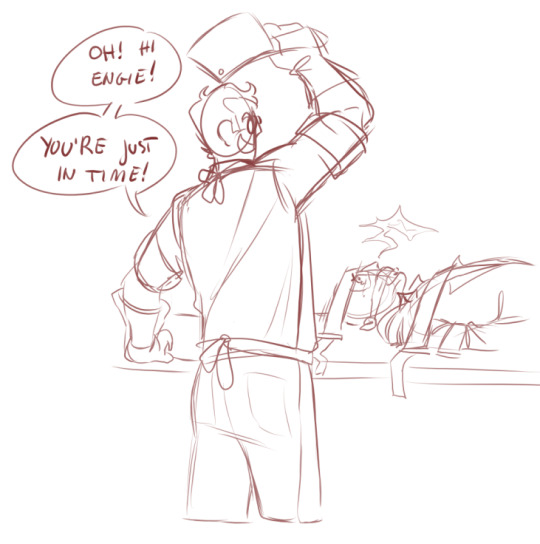



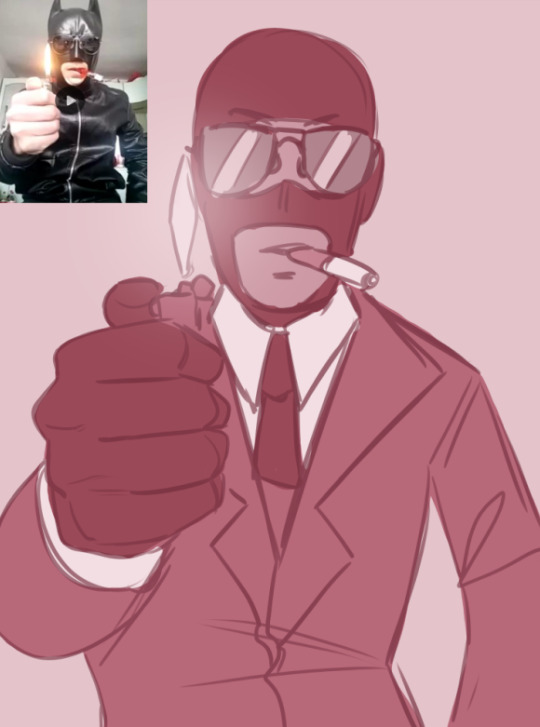
surprise, i'm not dead, here's some practical espionage
#sometimes i forget that i have a tumblr#there's been a lot happening lately. i've mostly been making art for my own enjoyment#i just forgot to post fysgef#anyways these are based on an rp i'm doing (mostly)#i just love these goobers okay#these are all monochrome lmao i just haven't changed my palette#i like this colour. it's convenient#tf2#tf2 fanart#engineer tf2#spy tf2#medic tf2#engiespy#napoleon complex#practical espionage#doodle dump#these are a little cringe but i don't care this is my blog i can do whatever i want
656 notes
·
View notes
Text

trains :)
this is a very rough and scribbly comic, but sometimes that's all a comic is going to end up being lmao. the guy with the jacket is darren, glasses is andy. not featured, andy's dead brother who nevertheless insists on haunting the subtext
the main thing I wanted to draw was the train tho
bsky ⭐ pixiv ⭐ pillowfort ⭐ cohost ⭐ cara.app
#darren and andy's brother were best friends and darren was there when andy's brother died#and made a very normal promise to always look out for andy. unfortunately. it's a little. hmmmm. suffocating! a decade later!#not that darren's been looking after andy for ten years. they were on opposite ends of a fictional planet#but in the way that andy's in love with darren and would be fine with dramatic declarations of 'i have to keep you safe' if they were#not attached to his dead brother. like. if that's the only reason he gets to hear words like that he would like to Not Hear Them thanks!#also andy is an extremely dangerous person in his own right so it's also like. hmm. hmmmmm.#it's messy. the death of andy's brother defined darren in a kind of way so the prospect of having to re define himself#without the absence of andy's brother to shape that is Unpleasant to think about#thankfully they're both going to be stuck on this fucking train for a significant amount of time! for my enjoyment!!! its train time baby!#long post#komiks tag#original tag
194 notes
·
View notes
Text
theyre jam buddies canon i say so
filbo definitely plays ukulele while buddy has absolutely NO musical knowledge so they just try to follow along the best they can hehehe
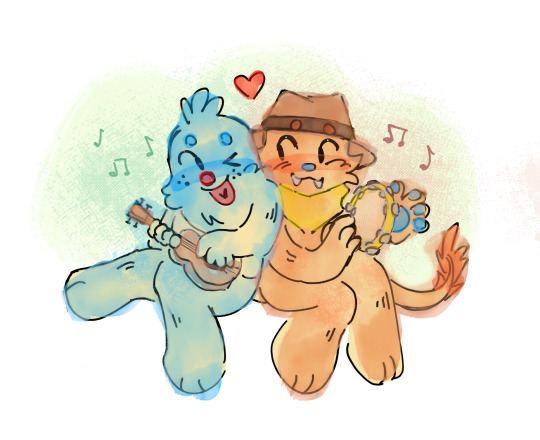
#bugsnax#the journalist bugsnax#bugsnax journalist#filbo fiddlepie#filbo x journalist#filbuddy#exam has been a pain in the ass sorry filbuddy enjoyers heres ur food#tfw everyday i check the filbuddy tag just to get slapped by my own posts repeatedly#filbuddy fans where are you please im starved
131 notes
·
View notes
Text

He’s red and he’s white and he’s green and he’s grey /
My bonny young dragon, come hither away...
Keith Windham and Nuntius, out of Luzula's stunning Flight of the Heron/Temeraire crossover fic 'The Flight of Dragons.'
#em draws stuff#em is posting about temeraire#temeraire#the flight of the heron#keith windham#PART ONE of the current massive I Need To Illustrate Other People's Tem Crossover Fic project!#luzula's fic is a really cool exploration of eighteenth century temverse britain and explores a lot of things that I too wished to know#about the history and variation of dragon-human partnership even within the british isles!!#really I think that this fic can and should be read by temeraire enjoyers even if they haven't read foth#(but also. if you read this and then want to read foth about this. More power to you &c &c)#other important thing to note here is how much nuntius's design owes to both the incredible tem fanart cataloguing being done by#esteemed tumblr user travellingdragon!! and their own design for greylings!!#...it was so weird to draw keith in a 1740s approximation of aviator uniform. he looks like just some guy now :]#also. caption lyrics are a modified version of real folk song 'my bonny moorhen' because I think I'm v funny and clever
81 notes
·
View notes
Text

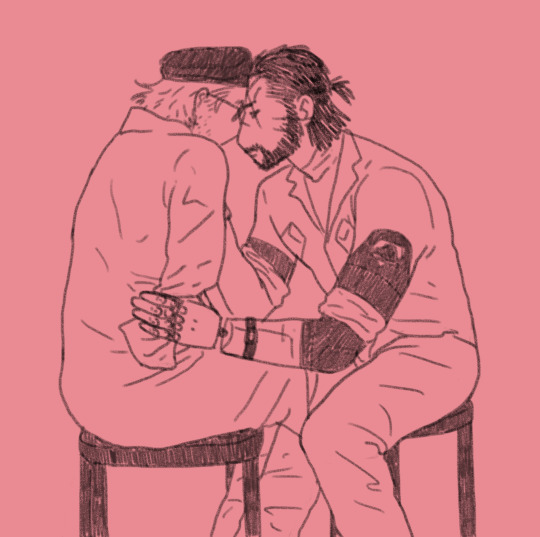
#metal gear#metal gear solid#mgs#kazuhira miller#venom snake#vkaz#the more i think abt it the more convinced i am that i became a kaz (& venom; just less) / vkaz enjoyer solely bc of those fucking gifs#pretty sure y'all know which ones.#like i was a raiden enjoyer but then i actually got into mgs n those gifs appeared a lot n there are so many analysis posts n they're just.#kaz decided to build his own paradise inside my head#he simply looks good w whoever you pair him with...#EDIT: I DIDN'T KNOW THE PIC I USED WAS FROM A FJCKING VINE BJT IT'S LITERALLY THEM EITHR WAY LMAO
119 notes
·
View notes
Text
u call touya daddy in bed and he starts gagging so hard he has to take a breather in the bathroom
#daddy dabi enjoyers this is my own personal silly not serious post i promise i promise#i just don’t think his daddy issues align with a daddy kink djdjd#vicspeaks
445 notes
·
View notes
Text
something to be said about how kristoph's only known mentee is a loud young man who dresses flashily, is particular about music and so passionate about the truth that he forgets to take people's feelings into account sometimes and follows the thread of logic even when it's disadvantageous to his case or people he cares about/admires. and who also does vocal training. like. just admit you miss your brother and go visit him. freak.
#to be clear this post is mostly a joke but i am serious about him being a freak and missing his brother.#sorry to all the pure evil kristoph enjoyers out there but i believe he loved his brother#kristoph gavin#klavier gavin#apollo justice#something so funny about the idea that kristoph looked at apollo & went 'omg... like klavier' in the same way that phoenix looked at ema#& went 'omg... just like maya fr' in rfta. the parallels are real to ME.#tangent but i feel like kristoph generally loves in the same way regardless of what type of love it is. i.e. buried beneath lots of self#justification about how it's not love and he's really tricking & using & manipulating them for his own means#17 y/o kristoph using his first pay check to buy klavier a guitar for christmas like 'yes... i will get him this instrument that is clearly#more COMMON & INFERIOR to my violin so he wont EMBARRASS me by being uncultured & not knowing anything about music... but he will ALWAYS#know he can't compare to me...'#vs 9 y/o klavier opening his present & being like 'wow! my older brother is so generous & cool <3 i love him so much <33#they're so funny to me actually
122 notes
·
View notes
Text
my dear,
my perfect darling
my love, my one and only
my yellow tulip.
i have picked up a small case, watson.
what is it?
i’m buying you some
diphylleia.
something trivial,
nothing to interest you.
i’ll be going out
to look at some flowers.
what for, holmes?
i hold you in my deepest
mauve carnations.
i believe i will
find some clues
there.
why haven’t i heard of this case?
it doesn’t exist
i am lying
i am making you a
a mulberry
i didn’t think it would
interest you, watson.
hmm. well, you must tell me about it later.
i cannot
you would hate me
i cannot bear that
a daffodil.
of course.
what particularly about flowers?
shit shit shit shit
a purple hyacinth.
flower language.
hmm.
he knows he knows he
cannot know how would he
clovenlip toadflax.
mm. i will see you.
don’t be late for dinner.
#johnlock#holmeswatson#h/w#john watson#sherlock holmes#poetry#storytelling#flower language#unrequited love#possibly unrequited love#acd johnlock#victorian johnlock#why am i tagging this like it's ao3#i might post it there actually#if you want to know the flower meanings they're on wikipedia#yellow tulip#diphylleia#mauve carnations#mulberry#daffodil#purple hyacinth#clovenlip toadflax#<- all of the flowers mentioned#have fun <3#vanny writes poetry and songs for her own enjoyment#TUMBLR STOP FUCKING UP MY POEM FORMAT CHALLENGE
83 notes
·
View notes
Text



13 cast in my AU where they live on pulse and no one get sucked into an alternative demotion
#A post for my other 5 ffxiii enjoyers homies in here#Look all im saying last time light and snow set on helping the same person the world nearly ended#Bart think sazh the only other responsible adult/ parent around here#hope estheim#Bartholomew estheim#lightning farron#sarah farron#i refuses a world were sarah and hope dont become besties and their cooperation give light a heart attack#Sarah a teacher helping her new friend (ligh son) into school#Vanille and fang are in this au too#Obviously never leaving my girls#They too help…. In their own way…#Saying no one got lost into another dimension but the min hope explains his proud math … we lost her#Im sorry it seems we lost lightning no Matter what we doo#snow villiers#ffxiii#Final fantasy xiii#final fantasy 13#sazh katzroy
93 notes
·
View notes
